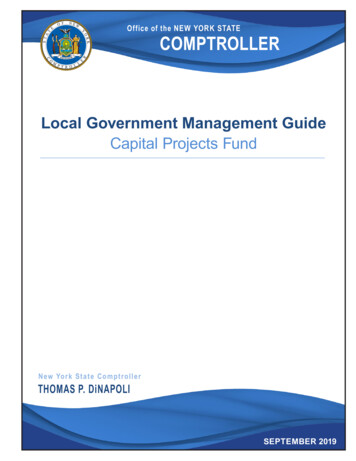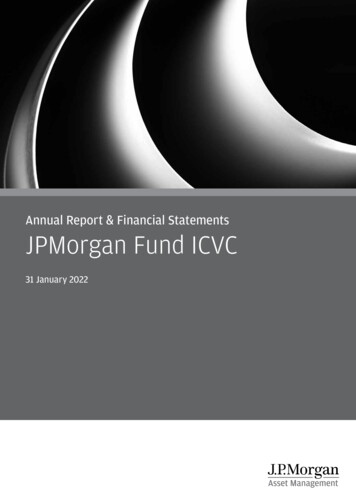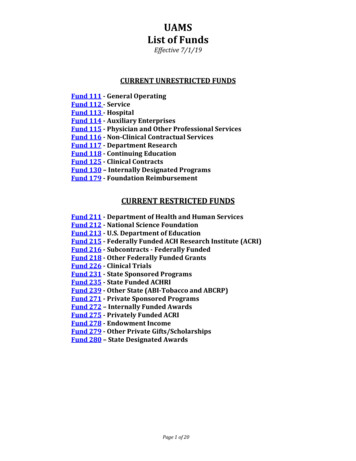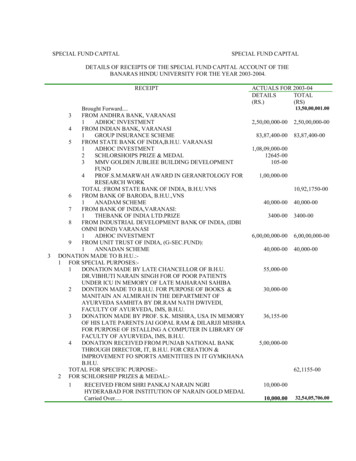
Transcription
Office of the NEW YORK STATECOMPTROLLERLocal Government Management GuideCapital Projects FundN ew Yo r k St a t e Co m p t ro ll e rTHOMAS P. DiNAPOLISEPTEMBER 2019
Table of ContentsIntroduction1Overview of Capital Projects Fund Accounting3Planning the Project6Budgeting for the Project7Monitoring and Reporting9Closing Out the Project10Use of Municipal Employees and Equipment11Change Orders13Retainage on Contracts14Transfers From Capital Reserves16Capital Project Debt18Serial Bonds18Bond Anticipation Notes20Installment Purchase Contracts23Earnings on Investment of Debt Proceeds25Bank Accounts26Disposition of Unexpended Balances27NYS Environmental Facilities Corporation – State Revolving Funds29Long-Term Loans30Short-Term Loans37Additional Resources42Notes43Division of Local Government and School Accountability Contacts45
IntroductionLocal governments undertake capital projects to acquire, develop, improve or maintain variousfacilities, other infrastructure and/or equipment. These projects are generally large in scale, requirelarge sums of money and are long-term. A capital projects fund is used to account for the financialresources supporting capital projects during the life of the project. However, because capitalprojects are budgeted on an individual basis, and legal and contractual requirements vary from oneproject to another, the complexity of accounting for them can be a challenge.The local governing board (board) is responsible for the oversight and management of capitalprojects, including ensuring that they are properly planned and managed, project funding isauthorized and costs are kept within the approved budget.This guide is intended to provide local officials with an overview of the use of capital projects fundsand guidance on the fundamentals of accounting for capital projects.Specifically, this guide will cover: An overview of capital projects funds, including the purpose of the fund and requiredaccounting records. An overview of the life cycle of a capital project, including key steps to consider in planning,the importance of budgeting, and essential monitoring and reporting activities that should beperformed by local government officials. Typical situations encountered and how to account for them in the capital projects fund: Use of local government employees and equipment in a capital project;Change orders for unanticipated conditions;Accounting for retained percentages; andTransfer of funds from capital reserves. Discussion of and journal entry illustrations for accounting for serial bonds, bond anticipationnotes and installment purchase contracts. Available financing options from the New York State Environmental Facilities Corporation’sRevolving Loan Fund, including sample journal entries for long-term and short-term loans.In this guide, the term “local governments” generally refers to all municipal corporations (counties,cities, towns and villages), school districts and boards of cooperative educational services (BOCES),district corporations (e.g., fire districts), special improvement districts governed by a separate boardof commissioners and public libraries.Local Government ManagementGuide CapitalProjectsFundIndustrialDevelopmentAgencies1
Please note that the information presented in this guide is general in nature and may not necessarilyapply to every situation encountered. For additional guidance, local officials are encouraged tocontact the Office of the State Comptroller (OSC) regional office for their locality (see the RegionalOffice Directory at the back of this guide) and/or their legal counsel.Additional OSC reference publications that may also be useful to local officials undertaking capitalprojects include: Local Government Management Guide: Capital Assets Local Government Management Guide: Multiyear Capital Planning Local Government Management Guide: Multiyear Financial Planning Cost-Saving Ideas: Capital and Repair Reserve Funds for Town or County Water and Sewer Cost-Saving Ideas: Capital Planning for Local Governments and School Districts.2Local Government Management Guide Capital Projects Fund
Overview of Capital Projects Fund AccountingPurpose of the Capital Projects FundThe purpose of a capital projects fund is to account for the financial resources to be used for theacquisition, construction or improvement of major capital assets other than those acquired throughproprietary or fiduciary funds. More specifically, capital projects funds are used to account for theacquisition or construction of capital assets and capital improvements financed through traditionalsources such as special State and federal grants, the proceeds of bonds or notes and installmentpurchase contracts (IPCs) authorized by New York State (NYS) General Municipal Law (GML)Section 109-b.The governing board is responsible for the oversight and management of capital projects, includingensuring that projects are properly planned and managed, project funding is authorized and costsare kept within the approved budget, while minimizing the possibility of cost overruns which couldhave a negative impact on finances.The acquisition, construction or improvement of capital assets can be accounted for in a localgovernment’s operating fund (e.g., general, highway, etc.) if the resources are provided through theoperating fund. However, if the acquisition or construction of a capital asset extends beyond oneyear, it should be accounted for in a capital projects fund.The proceeds of indebtedness are generally the major funding source for capital projects. However,other financing sources can include any or all of the following: grants, State aid, federal aid,gifts and donations, budgetary appropriations (e.g., interfund transfers, fund balance), insurancerecoveries and capital reserve funds.Measurement Focus and Basis of AccountingThe capital projects fund is a governmental fund using the alpha code “H” derived from the NYSUniform System of Accounts. Governmental funds measure the flow of current financial resources,such as cash and other current assets, and use the modified accrual basis of accounting torecognize transactions.Revenues should be recognized in the accounting period in which they become available and tothe extent that they represent an inflow of current financial resources. Revenues will be recorded asreceived in cash, except for revenues susceptible to accrual. Revenues from federal, State or othergrants, if based on expenditure of funds, should be recognized when expenditures are paid.Expenditures should be recognized in the accounting period in which the fund liability is incurredand to the extent that they represent an outflow of current financial resources. It is important tonote that encumbrances are not expenditures. Instead, encumbrances represent funds set aside forplanned future expenditures.Local Government ManagementGuide CapitalProjectsFundIndustrialDevelopmentAgencies3
Required Accounting RecordsA separate capital projects fund should be established for each authorized project. Separate fundsare needed because capital projects are budgeted on an individual project basis, and the legal andcontractual requirements vary from one project or class of projects to another. Occasionally, severalrelated projects will be combined under a single authorization by the board and may be accountedfor in a single capital projects fund. For example, a series of street paving projects carried outover an extended period of time by a local government with funds provided by a single bondauthorization and issue would be accounted for in a single fund.Individual accounting records must also be maintained for each capital project and should containsufficient information to track and report a project’s complete financial history (i.e., resourcesreceived and expended). General ledger accounts are used to summarize all capital projects fundtransactions. Subsidiary revenue accounts are used to record estimated revenues, actual revenuesreceived and the balance to be realized. Likewise, subsidiary expenditure accounts are used torecord appropriations as budgeted (with modifications), actual expenditures, encumbrances andunencumbered balances.Expenditures are recorded by functionalunit and use .2 to designate the object ofexpenditure as equipment and capital outlay.For example, H1620.2 would be the code forthe construction of a municipal office building.At the discretion of the local government,expenditure coding can be expanded withsubcodes to the right of the .2 object ofexpenditure to include various project phasesor aspects. The following codes couldbe used, for example, to account for theexpenditures related to the construction of amunicipal office ect FeesH1620.22Legal FeesH1620.23Use of Municipal Equipment and PersonnelH1620.24Building ConstructionH1620.25Interest Expense** Interest on obligations issued for a project may be charged asa project expenditure during the construction period or as anexpenditure in the operating fund responsible for the project(e.g., general fund).While local governments may create their own internal subcodes to the right of the .2 object ofexpenditure within their accounting system, when reporting to OSC in the year-end annual updatedocument (annual financial report), all .2 expenditure codes are reported in aggregate.4Local Government Management Guide Capital Projects Fund
The liability for long-term obligations issued to finance a project will not be recorded in the capitalprojects fund, but will be accounted for in the Schedule of Non-Current Governmental Liabilities (W)account group. This includes the proceeds of bonds, capital notes and IPCs. The account codes areas follows:CodeDescriptionDebitW129W623W626Total Non-Current Governmental LiabilitiesTerm Bonds PayableBond Anticipation Notes Payable1XXXW627W628W685W689Capital Notes PayableBonds PayableInstallment Purchase DebtOther Long-Term Debt (Specify)CreditXXXXXXXXXXXXXXXXXXCapital assets acquired through a capital projects fund are accounted for in the Schedule of NonCurrent Governmental Assets (K) account group at the completion of a project or at year-end (e.g.,Work in Progress). The account codes are as 06K107K159LandBuildingsImprovements Other Than BuildingsMachinery and EquipmentConstruction Work in ProgressInfrastructureOther Capital AssetsTotal Non-Current Governmental AssetsXXXXXXXXXXXXXXXXXXXXXCreditXXXLocal Government ManagementGuide CapitalProjectsFundIndustrialDevelopmentAgencies5
Planning the ProjectIt is imperative that local officials take the steps necessary to ensure that essential capital projectsare identified and that funds are available to finance them. To achieve these goals, officials need todevelop a multiyear capital plan that will assist them in forecasting when financial resources maybe necessary to support capital expenditures. A comprehensive capital plan allows local officialsto establish priorities and determine the best method for paying these costs. For more guidance ondeveloping a multiyear capital plan, see the OSC Local Government Management Guide: MultiyearCapital Planning.2Once a project or acquisition is included in a capital plan, local officials should consider severalfactors prior to going forward with the listed projects or equipment acquisitions. The followingquestions should be answered prior to making final decisions on capital projects or acquisitions: Is there sufficient time to permit the local government to satisfy the necessary engineering andlegal requirements, as well as to meet any public notice and public hearing requirements? Will the project or purchase require mandatory or permissive referendums? Will the project or acquisition require competitive bidding or requests for proposals?3 How will the project or acquisition be financed? Is grant money available? Have reserve funds been established with sufficient funds available to help finance theproject? Will operating funds be required to provide support for the project through interfund loansor transfers? Does the project or acquisition lend itself to consideration of a joint municipal project with aneighboring municipality or school district? Who will be responsible for overseeing the project? Can someone be hired specifically for thispurpose or will this be an additional duty for someone already on the payroll? What is the projected time frame for project completion? Will periodic reports be required on the project’s status? After the project is completed, will the local government have sufficient resources to pay forcontinuing operating and/or maintenance expenses?6Local Government Management Guide Capital Projects Fund
Budgeting for the ProjectUnlike other governmental funds that are required to have an annual budget, the budget of a capitalproject is project-oriented and is typically undertaken separately from (but may influence) the localgovernment’s formal annual budget process. However, each capital project needs a budget, and thebudget should be recorded in the accounting records. The project budget should be for the project’slife and amended only if the budgeted amount changes during the project. At fiscal year-end, thecapital projects fund’s budget is not closed out, unlike all other governmental funds. However,revenues and expenditures are closed out to fund balance.The board is responsible for providing proper budgetary control and overseeing the capital projectsfund’s budget. It is essential to use budget modifications to prevent the over-appropriation ofavailable funds. The board should use budget status reports to ensure compliance with requiredbudgetary control procedures. Additionally, the board is required to ensure compliance with localpolicies (e.g., procurement, cash management and investment) and laws that would pertain to thecapital project.The following journal entries illustrate budgeting for the costs of an authorized 2,175,000 capitalproject for the construction of a municipal office building and the manner in which it will be financed.AccountSubsidiary AccountH510 Estimated RevenuesH5710 Serial BondsH5031 Interfund Transfer*H3097 State Aid, Capital ProjectsH960 AppropriationsH1620.21 Engineering FeesDebitCredit 2,175,000 2,000,000 25,000 150,000 2,175,000 23,000H1620.22 Legal FeesH1620.23 Use of Municipal Equipment and PersonnelH1620.24 Building ConstructionH1620.25 Interest Expense 13,500 34,800 2,076,200 27,500* Must also include an appropriation for the transfer in the general fund.Local Government ManagementGuide CapitalProjectsFundIndustrialDevelopmentAgencies7
The project budget should periodically be compared with the actual revenues and expenditures.Because projects can span over several years, comparing the project budget with current yearrevenues and expenditures may not give an accurate picture regarding the project’s finances. Forthat reason, records must be kept to allow the project budget to be compared to the actual revenuesand expenditures over the project’s life to get an accurate comparison. For example, the followingillustrates how actual expenditures and encumbrances are compared to the project budget for aproject that has spanned a three-year period:Actual / 620.24H1620.25Engineering FeesLegal FeesUse of Municipal Equipmentand PersonnelBuilding ConstructionInterest ExpenseTotal Expenditures8201620172018AvailableBalance 23,000 13,500 12,500 6,500 8,300 4,200 0 1,250 2,200 1,550 34,800 25,895 6,750 1,250 905 2,076,200 27,500 785,789 0 967,980 18,450 184,655 9,050 137,776 0 2,175,000 830,684 1,005,680 196,205 142,431Local Government Management Guide Capital Projects Fund
Monitoring and ReportingRegularly Monitor Financial ActivityOnce a capital project budget has been established and the project has begun, local officialsand/or their designees should monitor the project activity on a regular basis. At a minimum, suchmonitoring should include: A review of project expenditures and encumbrances in relation to the project budget andawarded contracts. The board must amend the project budget when necessary to prevent appropriation itemsfrom being overdrawn. A review of the availability and timeliness of revenue sources identified in the capital budget. A confirmation of the adequacy of cash flow needs necessary for the timely completion of theproject. A review of project status compared to initial projected timelines.Report on Project Status and ActivitiesProducing project status reports will assist local officials throughout the project with trackingbudgeted revenues and making informed decisions, such as considering change order requestsand meeting cash flow demands. Meaningful reports provide a comparison of actual results to theproject plan, and should include: Revenue and expenditure activity in comparison to the project budget, showing: Available appropriations; and Percentage of project budget expended. Percentage of project completed in comparison to the initial timeline projected. Significant changes to project scope or costs.Local Government ManagementGuide CapitalProjectsFundIndustrialDevelopmentAgencies9
Closing Out the ProjectUpon the project’s completion, local officials should ensure that the necessary actions are taken tofinalize the project, including the following: Ensure that the designated person (engineer, architect, etc.) signs off on the project’scompletion once the work has been determined to be satisfactory. Approve the project’s closure and make sure that authorizing records are closed outappropriately within all the systems used to manage, monitor and report on the project. Confirm that the established procedures for the acceptance of project work and final projectcompletion have been followed. When applicable, held retainage amounts are released to contractors after satisfactorycompletion of contract work. Transfer residual project moneys to the applicable operating fund or reserve in the debt servicefund. Confirm that new capital assets are properly recorded in the Schedule of Non-CurrentGovernmental Assets.10Local Government Management Guide Capital Projects Fund
Use of Municipal Employees and EquipmentIf a local government uses its own employees and equipment for a capital project, the projectshould be charged for these costs. The manner in which the project and the contributing fund(s) arecharged depends on whether the services were intended to be treated as an in-kind contribution tothe project or as a reimbursable cost.4Example: The gross payroll for a crew from a village department of public works (DPW) for a payperiod was 1,000. The crew spent 40 percent of the pay period performing excavation work fora village building project and the other 60 percent maintaining village streets. In addition, villageexcavation equipment was used for six hours on the project at 75 per hour (pursuant to the NYSDepartment of Transportation rental schedule).If the village board’s intention is to have the general fund contribute in-kind services to the capitalproject, the accounting entries are:1. To record the village’s gross payroll for the pay period in the general fund.AccountSubsidiary AccountA522 ExpendituresA5110.1 Maintenance of Roads, Pers ServA8662.1 Public Works, Site ImprovementsA200 CashDebitCredit 1,000 600 400 1,0002. To record the use of village employees and excavation equipment as a project expenditure in thecapital projects fund.AccountSubsidiary AccountH522 ExpendituresH1620.23 Use of Municipal Equipment and EmployeesH2780 Contributed ServicesDebitCredit 850 850 850However, if the village board requires the capital projects fund to reimburse the general fund for theuse of DPW personnel and equipment, the accounting entries are as follows:1. To record the village’s gross payroll for the pay period in the general fund.AccountA522 ExpendituresA5110.1 Maintenance of Roads, Pers ServA391 Due From Other FundsA200 CashSubsidiary AccountDebitCredit 600 600 400 1,000Local Government ManagementGuide CapitalProjectsFundIndustrialDevelopmentAgencies11
2. To record the general fund’s voucher billing of the capital projects fund for equipment rental.AccountSubsidiary AccountA391 Due From Other FundsA980 RevenuesA2414 Rental of EquipmentDebitCredit 450 450 4503. To record the liability in the capital projects fund for the reimbursement to the general fund forDPW equipment and personnel used.AccountSubsidiary AccountH522 ExpendituresH1620.23 Use of Municipal Equipment and PersonnelH630 Due To Other FundsDebitCredit 850 850 8504. To record the payment from the capital projects fund to the general fund.AccountDebitH630 Due To Other FundsH200 CashCredit 850 8505. To record the general fund’s receipt of payment from the capital projects fund.AccountDebitA200 CashA391 Due From Other Funds12Local Government Management Guide Capital Projects FundCredit 850 850
Change OrdersCapital projects are complex undertakings. Good planning and ongoing project management usuallyallow them to be completed within the original cost and scope. However, unanticipated conditionsmay require change orders to authorize additional or reduced work.A change order is a formal construction contract modification, agreed upon by both local officialsand the contractor, to authorize a change in the work, an adjustment in the project cost or a changein the contract time. Because the board authorizes construction contracts and professional servicecontracts, it must also review proposed changes to these agreements. Change orders must bepresented to the board for approval in a timely manner and should be reviewed by the board aspromptly as possible to ensure each change order is approved before any additional work is started.Change orders will often result in modifications to the capital project budget, which also requireboard approval. The board should document their review and approval of change orders in themeeting minutes.The following is an example of how to record an adjustment in the project budget reflecting achange order for unanticipated legal fees.AccountH510 Estimated RevenuesH5031 Interfund TransferH960 AppropriationsH1620.22 Legal FeesSubsidiary AccountDebitCredit 15,000 15,000 15,000 15,000Local Government ManagementGuide CapitalProjectsFundIndustrialDevelopmentAgencies13
Retainage on ContractsIn construction contracts, retainage generally is a sum of money withheld by the local governmentfrom progress payments made to a contractor until satisfactory completion of work. Retainage isa form of security for proper completion of the work under the construction contract. It is typicallycalculated as a percentage of the progress payment. GML allows for local governments to retain upto 5 percent of each progress payment to the contractor when the contractor is required to providea performance bond and labor and material bond, both in the full amount of the contract. In all othercases, the local government may retain up to 10 percent of each progress payment.GML Section 106 provides that contractors, from time to time, may withdraw, at their option,the whole or any portion of the amount retained from the contractor’s payments pursuant to thecontract’s terms, upon depositing with the municipality’s fiscal officers (or if so directed by the fiscalofficer, with a designated bank or trust company having an agreement with the fiscal officer), certainsecurities having a market value equal to the amount so withdrawn: United States of America (USA) bonds and notes or obligations, the payment of which isguaranteed by the USA. NYS bonds and notes. NYS bonds of any political subdivision.Interest earned on the obligations being held as security is due to the contractor unless there isan agreement stating otherwise. The fiscal officer is permitted to charge the contractor a servicecharge for receiving, handling and disbursing the obligations, as well as any funds and coupons. Theservice charge may not exceed a reasonable amount which is generally consistent with charges bya bank or trust company for such services.5The following are the journal entries for withholding retainage on a municipal office buildingconstruction contract when it is not yet owed to a contractor.1. To record payment to the contractor for construction-in-progress (billing of 10,000 with 10percent retainage withheld).AccountSubsidiary AccountH522 ExpendituresH1620.24 Building ConstructionH200 CashAccount14Local Government Management Guide Capital Projects FundCredit 9,000 9,000 9,000Subsidiary AccountH521 EncumbrancesH1620.24 Building ConstructionH821 Reserve for EncumbrancesDebitDebitCredit 1,000 1,000 1,000
2. To reclassify the form of retainage when the contractor replaces retained cash with eligiblesecurities.AccountDebitH455 Securities and MortgagesH200 Cash 1,000Credit 1,0003. To release retainage to the contractor after completion of construction work.AccountSubsidiary AccountH522 ExpendituresH1620.24 Building ConstructionH455 Securities and Mortgages*DebitCredit 1,000 1,000 1,000* If cash has been replaced by securities as in journal entry #2.AccountH821 Reserve for EncumbrancesH521 EncumbrancesH1620.24 Building ConstructionSubsidiary AccountDebitCredit 1,000 1,000 1,000For additional information on retainage, see our accounting bulletin entitled Accounting for RetainedPercentages.6Local Government ManagementGuide CapitalProjectsFundIndustrialDevelopmentAgencies15
Transfers From Capital ReservesCapital reserves are reported as restricted fund balance in the fund financing the reserve or in theauthorized capital projects fund. Once a project has been authorized by the board to include the useof capital reserve moneys (previously financed and accounted for in an operating fund), this moneycan be transferred to an authorized capital projects fund to pay project expenditures.7 However, thelocal government’s accounting records must separate the reserve moneys from other capital projectrevenue sources.The reserve’s unexpended balance must be classified as restricted fund balance in the capitalprojects fund at year-end. Therefore, interfund revenues (H5031) derived from a transfer fromcapital reserves must be closed to restricted fund balance (H878) and project expenditures paidwith reserve moneys must also be closed to restricted fund balance.Example: The town board has approved a 2.5 million capital project for the construction of ahighway garage which will be financed in part by 550,000 from the general fund building capitalreserve. On November 5, the supervisor transfers the reserve moneys to the capital projects fund tobe used to pay the board-approved project expenditures.1. To record the transfer of capital reserve money from the general fund to the capital projects fund(assume this transfer had already been budgeted in the general fund).AccountSubsidiary AccountA522 ExpendituresA9950.9 Transfer to Capital Projects Fund*A230 Cash, Special ReservesDebitCredit 550,000 550,000 550,000* This expenditure in the general fund must be closed to the capital reserve (A878) at year-end.AccountSubsidiary AccountH230 Cash, Special ReservesH980 RevenuesH5031 Interfund TransferDebitCredit 550,000 550,000 550,0002. To record the payment of November’s board-approved project expenditures totaling 245,100.AccountSubsidiary AccountH522 ExpendituresH5132.2 Garage, Capital OutlayH230 Cash, Special Reserves16Local Government Management Guide Capital Projects FundDebitCredit 245,100 245,100 245,100
3. To record the payment of December’s board-approved project expenditures totaling 187,345.AccountSubsidiary AccountH522 ExpendituresH5132.2 Garage, Capital OutlayH230 Cash, Special ReservesDebitCredit 187,345 187,345 187,3454. To close project revenues and expenditures at year-end.AccountSubsidiary AccountH980 RevenuesH5031 Interfund TransferH878 Capital ReserveDebitCredit 550,000 550,000 550,000H878 Capital ReserveH522 ExpendituresH5132.2 Garage, Capital Outlay 432,445 432,445 432,445After making the closing entries, the capital projects fund’s balance sheet at year-end would showthe following:AssetsLiabilities and Fund EquityH230 Cash, Special Reserves 117,555H878 Capital Reserve 117,555Total Assets 117,555Total Liabilities and Fund Equity 117,555Local Government ManagementGuide CapitalProjectsFundIndustrialDevelopmentAgencies17
Capital Project DebtNote: As this guide is a reference for accounting and reporting for the capital projects fund, localgovernment officials should consult with their municipal attorney for legal guidance related to debtissuances.Serial BondsSerial bonds are authorized by NYS Local Finance Law (LFL) Section 21.00 and are often issued bylocal governments to finance long-term capital projects (i.e., generally, more than five years). Serialbonds may be issued for any object or purpose for which the issuer is authorized to expend moneyand for which the State Legislature has established a period of probable usefulness (PPU) (see LFLSection 11.00). The proceeds of serial bonds may only be used for the object or purpose for whichthe bonds were issued or to pay debt service on the bonds (LFL Section 165.00).Statutory Installment Bonds (SIBs) may also be issued as a form of long-term debt, with certainlimitations (LFL Section 62.10). This form of debt may have cost advantages for local governments,due to the issuance of a single bond rather than multiple serial bonds.The issuance of bonds must be authorized by a bond resolution (see LFL Section 31.00) which, inmost cases, must be adopted by at least a two-thirds vote of the finance board (see LFL Section33.00). For example, in the case of a town board consisting of five members, four members wouldneed to vote to affirm the bond resolution. However, a three-fifths vote is sufficient when either thebond resolution is
New York State Comptroller THOMAS P. D. iNAPOLI. COMPTROLLER. Office of the . NEW YORK STATE. Local Government Management Guide . Capital Projects Fund. SEPTEMBER 2019. Table of Contents. Introduction 1 Overview of Capital Projects Fund Accounting 3 Planning the Project 6 Budgeting for the Project 7 Monitoring and Reporting 9. Closing Out the Project 10 Use of Municipal Employees and Equipment .










